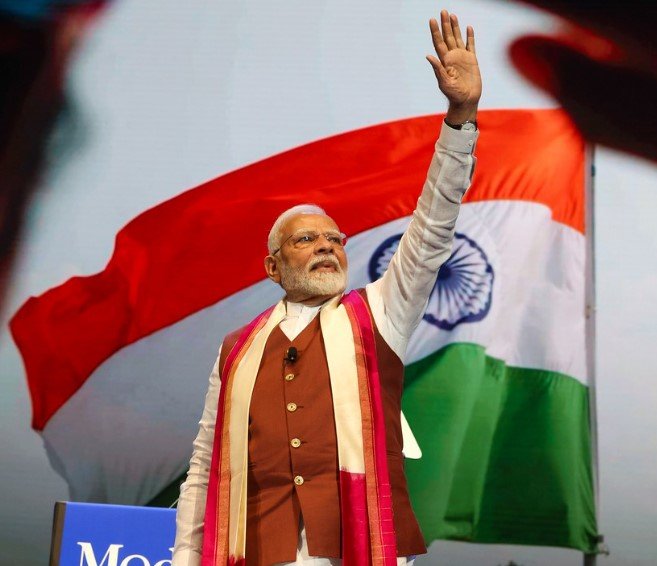Surprise airbase visit doubles as a warning: India’s red line on terrorism is no longer blurry
Prime Minister Narendra Modi’s sudden appearance at Punjab’s Adampur airbase wasn’t just a morale boost for troops. It was a full-throated signal — aimed squarely at Pakistan — that India’s tolerance for cross-border terrorism has run dry.
Backed by the silhouette of an S-400 missile launcher, Modi made it crystal clear: any future terror attack on Indian soil will be met with a fierce and deliberate counterstrike. His message wasn’t just loud — it was meant to echo.
Adampur Airbase: From Airshow to Statement of Intent
The May 13 visit came on the heels of Operation Sindoor — a short, sharp, four-day military response to a recent escalation across the western border. Though details remain classified, Modi’s choice to visit Adampur spoke volumes.
This is one of the Indian Air Force’s most strategic outposts, barely 100 kilometers from the India-Pakistan border. The S-400, Russia’s sophisticated missile defense system, provided the perfect backdrop for his words.
“India’s Lakshman Rekha against terrorism is now crystal clear. India will respond strongly if hit by a terror attack and our response will be at a time of our choosing, on our conditions and in our way.”
That line drew attention not just in Delhi but in Islamabad too.

Operation Sindoor: Short, Brutal, and Tightly Coordinated
Though the government hasn’t released a full briefing, officials familiar with the situation described Operation Sindoor as a pre-planned, highly coordinated strike carried out across multiple domains — air, land, and cyber.
The operation reportedly targeted launchpads and infrastructure allegedly used by Pakistan-backed terror groups. It also included precise air sorties and drone missions across the Line of Control.
One official said on condition of anonymity that the response was “measured, but lethal.”
• It lasted four days.
• There were no reported civilian casualties on the Indian side.
• The Air Force, Army, and Navy worked in lockstep.
• Drones played a major role, especially in surveillance and targeting.
• The objective was deterrence — not escalation.
Sources said Indian forces returned without casualties, and that surveillance continues 24/7.
Red Line Drawn: A New Normal?
Modi’s remarks are likely to be studied not just by military strategists, but also by political analysts and global think tanks. Because what he said at Adampur wasn’t the usual rhetoric.
It was a declaration — India has redrawn its red lines.
Previous prime ministers have spoken of “measured response” and “strategic patience.” Modi chose different words. Words like “fierce,” “our terms,” and “destruction.”
He didn’t just call out terror groups. He warned their handlers. That includes Pakistani intelligence, according to defense analysts.
One sentence stood out.
“Terror bosses in the neighbouring country now know their actions won’t go unanswered.”
Mixed Signals Abroad: Global Reactions Are Cautious
The U.S. State Department urged restraint but didn’t criticize the operation. Russia, which supplies India’s defense hardware including the S-400s, remained quiet. China made a generic call for peace and stability in the region.
Meanwhile, Pakistani media was predictably reactive. Some commentators called the airstrikes “aggressive provocation.” Islamabad officially denied any involvement in the events that triggered Operation Sindoor.
But back in Washington and Brussels, there seems to be a quiet acknowledgment that India’s patience has limits.
Here’s a snapshot of early global reactions:
| Country | Reaction Type | Key Message |
|---|---|---|
| USA | Neutral | “Urge both sides to avoid escalation” |
| Russia | Silent | No official comment yet |
| China | Diplomatic | “Hope regional peace is maintained” |
| France | Supportive | “India has a right to self-defense” |
| Pakistan | Defensive | “Unprovoked aggression” |
The Bigger Picture: Elections, Security, and Symbolism
Of course, timing is everything in politics. And this show of strength is landing just months ahead of India’s next general election. Modi’s party has consistently leaned on national security as a campaign pillar.
But this isn’t just about optics.
Military sources confirmed that multiple strategic exercises are underway. The aim? Show preparedness. Test logistics. Project strength.
Meanwhile, Adampur wasn’t chosen at random.
It’s a legacy airbase. One of the oldest. Key during the 1971 war. And now — symbolically — the site where Modi declared India’s zero-tolerance stance.
What Happens Next?
The temperature at the border is cooler for now. But Indian troops remain on high alert.
There’s chatter about cyber-defense drills in the coming days. Troop movements in Jammu and Kashmir have also picked up, though officials say it’s routine.
Modi is expected to hold a high-level security meeting later this week, focusing on hybrid threats — including social media propaganda and deepfake warfare.
